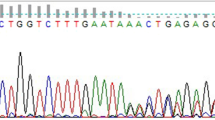Abstract
Double heterozygosity for HbS and HbE is rare. HbS and HbE are seen in SC, ST and OBC communities from this part of country. Inter caste marriages amongst these communities have resulted into this compound heterozygous condition. Double heterozygous state for HbS and HbE is clinically silent as compared to HbS-β Thalassaemia and HbSS cases. At Regional Hemoglobinopathy Detection and Management Center, we report a case of 15-year-old male, Teli (OBC) by caste who came for screening for sickle cell disorder. Sickling, solubility test and Hb electrophoresis on agar gel at alkaline pH was carried out. His sickling and solubility tests were positive and on hemoglobin electrophoresis it showed two bands one at Hb A2 position and another at HbS position. For further confirmation sample was subjected for quantitation of haemoglobin on high performance liquid chromatography (HPLC), Bio-Rad. On quantitation he was having HbS 59.8%, HbE 33.5% and HbF 3.2% confirming his double heterozygous state for HbS and HbE. On family screening his father turned out to be sickle cell trait and mother as hemoglobin E trait.
Similar content being viewed by others
Abbreviations
- Hb:
-
Hemoglobin
- HbA2 :
-
Hemoglobin A2
- HbC:
-
Hemoglobin C
- HbD:
-
Hemoglobin D
- HbE:
-
Hemoglobin E
- HbF:
-
Fetal Hemoglobin
- HbS:
-
Sickle Hemoglobin
- HPLC:
-
High Performance Liquid Chromatography
- Glu:
-
Glutamic acid
- I.G.M.C.:
-
Indira Gandhi Medical College
- Lys:
-
Lysine
- MCH:
-
Mean Corpuscular Hemoglobin
- MCHC:
-
Mean Corpuscular Hemoglobin Concentration
- MCV:
-
Mean Corpuscular Volume
- OBC:
-
Other Backward Class
- O/E:
-
On Examination
- RBC:
-
Red Blood Cell
- RDW:
-
Red Cell Distribution Width
- SC:
-
Schedule Caste
- ST:
-
Schedule Tribe
References
Lukens JN (1999) The Abnormal Hemoglobins: General Principals in Lee G, Foerster J, Lukens J et al editors: Wintrobe’s Clinical Hematology, 10th ed, Vol. 1. Williams and Wilkins, A Waverly Company, Batimore, USA pp 1333–1343
Balgir RS (1992) Serogenetic variation in a Mech-Kachari tribal population. Man in India 72:293–230
Balgir RS and Sharma SK (1988) Distribution of sickle cell hemoglobin in India. Indian J Hemat 6:1–14
Balgir RS (1996) The prevalence of sickle cell Hemoglobinopathy in India. In The Encyclopedia of Dravidian Tribes (eds Menon, T. M., Sivathanu, C., Prasanth, K. P., Sasikumar, M. and Mathur, P. R. G.), The International School of Dravidian Linguistics, Trivandrum, vol. 1, pp 21–29
Balgir RS (1995) Spatial distribution of red cell hemoglobin D variant in India. Indian Practr 48:128–135
Saha N, Banerjee B (1973) Hemoglobinopathies in the Indian subcontinent. Acta Genet Med Gemellol 22:117–138
Sharma A (1983) Hemoglobinopathies in India. In peoples of India: some genetical aspects. New Delhi: ICMR, 31–49
Mohanty D, Pathare AV (1998) Sickle cell Anemia-the Indian scenario. Indian J Hematol blood transfus 16:1–2
Balgir RS (1996) Genetic epidemiology of the three predominant abnormal Hemoglobins in India. J Assoc Phys India 44:25–28
Balgir RS (2003) Emerging trends in genetic epidemiology of haemoglobinopathies in Seven Sister States of North Eastern India. In Anthropological Perspectives: North East India (Eds Das Rajat Kumar and Basu Debashish), Akansha Publishing House, New Delhi
Sukumaran PK, Randelia HP, Sanghvi LD, Merchan SM (1961) Thalassaemia syndrome in Mumbai. J Assoc Physican India 9:477
Sharma RS, Parekh JG, Shah KM (1963) Haemoglobinopathies in western India. Annual Report Indian Soc Hemat 4: 36
Ambekar SS, Phadke MA, Mokashi GD, Bankar MP, Khedkar VA, Venkat V, Basutkar DG (2001) Pattern of Hemoglobinopathies in Western Maharashtra. Indian Pediatrics 38: 530–534
Bio-Rad, Variant™ Version 3. β Thal Short Program, Library of Abnormal Hemoglobins. 1999, Catlog No.270-0259,700:469
Wang WC, Lukens JN (1999) Sickle Cell Anemia and Other Sickling Syndromes, in Lee G, Foerster J, Lukens J, et al, editors: Wintrobe’s Clinical Hematology, 10th ed, Williams and Wilkins, A Waverly Company, Batimore, USA, p 1381
Keren DF (2003) Clinical evaluation of hemoglobinopathes: Part II. Stuctural changes. The Warde Report Vol. 14, No. 3
Author information
Authors and Affiliations
Rights and permissions
About this article
Cite this article
Dani, A.A., Shrikhande, A.V. Double heterozygous for hemoglobin S and hemoglobin E — a case report from central India. Indian J Hematol Blood Transfus 23, 119–121 (2007). https://doi.org/10.1007/s12288-008-0012-0
Published:
Issue Date:
DOI: https://doi.org/10.1007/s12288-008-0012-0




